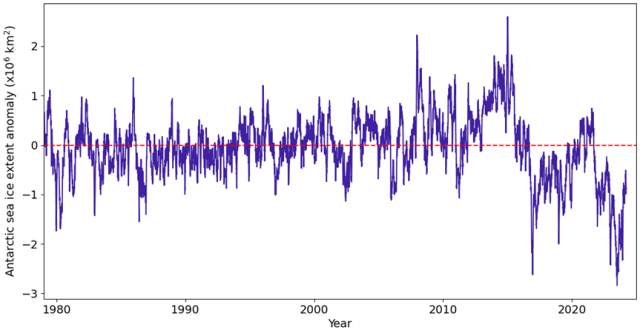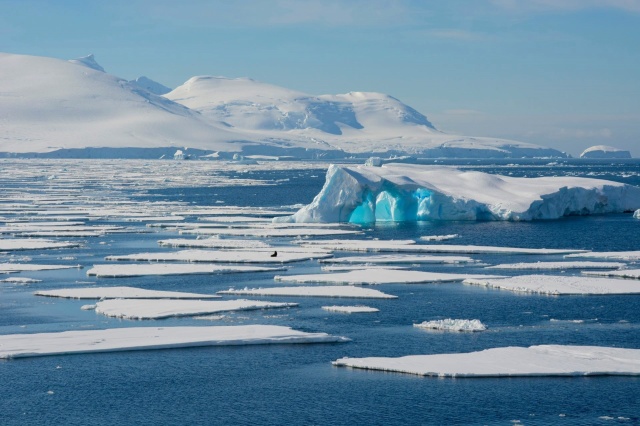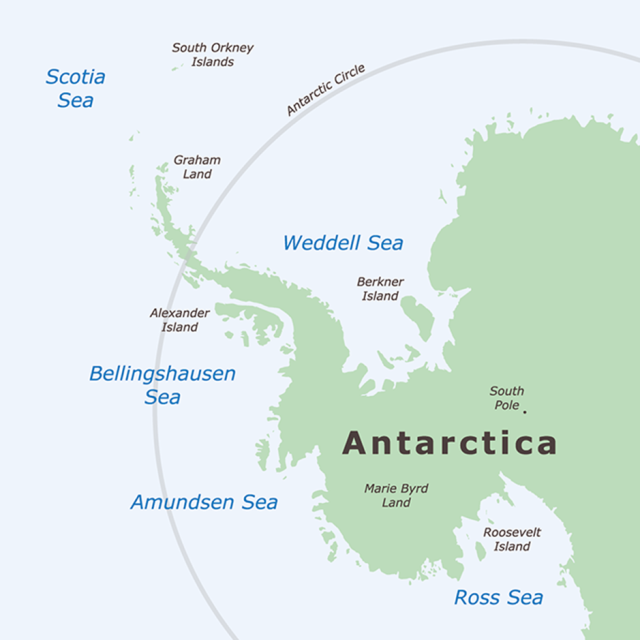Weather
Is the UK winter going as forecast?

There has been much coverage of the weather in recent weeks with what has so far felt like an unusually stormy autumn and winter, followed by a spell of extremely cold weather with impacts from snow and ice for many, and then on Sunday (28/01/24) a new provisional maximum temperature record for the UK for January was recorded in northwest Scotland.
To understand what has been happening over the last few months and what we might expect for the coming months, we need to look at the weather outside the UK. Global weather is interconnected and large-scale global weather and climate systems, known as climate drivers, can have major impacts on the UK at this time of year. So, what are these drivers and what are they doing at the moment?
Climate Drivers
El Niño, the naturally occurring warming of the Pacific Ocean, releases heat into the atmosphere, creating warmer and wetter air which can trigger extreme weather around the globe, resulting in impacts such as the ongoing drought in the Amazon.
As we are all aware, so far this winter, the UK, has had a wet and stormy December followed by a colder spell in January. This type of weather is consistent with what we would expect during an El Niño winter. Although we are now in a milder interlude with westerly and southerly winds, the long-range outlook still contains a good chance of a return to colder conditions.
Earlier this month the Met Office announced that globally, 2023 was the warmest year on record (data back to 1850), and it was the tenth successive year that has equalled or exceeded 1.0 °C above the pre-industrial period (1850-1900). Professor Adam Scaife, Principal Fellow and Head of Monthly to Decadal Prediction at the Met Office, said: “The above average temperatures have been driven largely by climate change but are topped up by El Niño. During an El Niño event, winds in the eastern Pacific weaken, keeping warm waters closer to the surface releasing more heat into the atmosphere and raising global temperature.
“The ongoing Amazon drought and wet conditions in parts of Northern Europe in December are also consistent with El Niño.”
Although El Niño has likely peaked in the tropics, its impacts are still being felt around the globe and Professor Adam Scaife, added: “The phenomenon could well lead to unprecedented global temperatures this year, with 2024 being the hottest year on record globally, potentially pushing the world temporarily past the key 1.5C warming milestone.”
El Niño is not the only factor driving our weather patterns. Other drivers influencing the UK this winter include the Quasi-Biennial Oscillation (QBO). This is a regular variation of the winds that blow high above the equator. The QBO is currently in an easterly phase, increasing the chance of cold northerly or easterly winds from the Arctic and continental Europe. The Stratospheric Polar Vortex, has tended to be weaker than normal so far this winter but its strength has now returned to around average, and its influence is likely to be limited in the immediate future. An active Madden-Julian Oscillation favours westerly winds over the UK during early February but then a reduction in westerly winds during mid and late February.
All these effects are happening on a background of warming UK winters, consistent with wider global warming trends.
Taking the ‘global drivers’ into consideration, our long-range forecast systems suggest February will start off mild, with the chance of cold weather increasing as we go through the month and into March. This means we could yet see some cold weather-related impacts such as snow and ice. This increased chance of cold does not exclude the possibility of milder conditions.
Despite any speculation you may read elsewhere, the science simply does not allow for specific detail on the amount of rain or snow over the coming months or exactly when severe weather may occur. However, long-range forecasts can provide useful information on the likelihood of possible conditions averaged over the whole of the UK.
The science of longer-range and seasonal outlooks is at the cutting edge of meteorology and the Met Office is one of the leaders in scientific research in the area. Even with ‘perfect’ prediction systems, the fundamentally chaotic nature of the atmosphere means these predictions will always be concerned with the likelihood of different kinds of possible weather conditions and the levels of risk of impacts they might bring. Even with ‘perfect’ prediction systems, the fundamentally chaotic nature of the atmosphere means these predictions will always be concerned with the likelihood of different kinds of possible weather conditions and the levels of risk of impacts they might bring.
You can check the long range forecast and daily weather forecast on our website. You can also follow us on Twitter and Facebook, as well as on our mobile app which is available for iPhone from the App store and for Android from the Google Play store. Our three-month outlooks are updated each month. Keep track of current weather warnings on the weather warning page.
Weather
A wet and dull April

It will be no surprise for many to hear that April 2024 has been a wet month. In what has felt like an unsettled spring so far, the UK has had its sixth wettest April since the series began in 1836, according to provisional statistics from the Met Office.
Sunshine has been in short supply, with the UK provisionally recording just 79% of its long-term average for the month.
Wetter than average
The UK experienced 55% more rainfall than an average April, with 111.4mm falling across the month, making it the sixth wettest April in the series and the wettest April since 2012.
Many areas recorded more than their long-term average monthly rainfall, with Scotland experiencing its fourth wettest April in a series which started in 1836. It saw 148.9mm of rainfall across the month – more than 60% of its average and the wettest April since 1947.
Some places in Scotland saw more than double their average rainfall for the month. Edinburgh in particular saw very large rainfall totals, receiving 239% of its average April rainfall, which is its second wettest on record, falling only behind totals in 2000. East and West Lothian, Aberdeen, Clackmannan, Berwickshire and Cumbria, among others, also recorded more than double their average rainfall in the month. A rain-gauge at Honister Pass in the English Lake District recorded more than 400mm of rain.
Met Office Scientist Emily Carlisle said: “April has been a continuation of the past few months: often wet, windy and unsettled. April showers were present from the beginning of the month, with frontal systems bringing persistent precipitation across the UK. Although a high-pressure system moved over the UK on the 20th bringing some drier weather, by the end of the month, low pressure was back in charge, bringing with it more rain.”

Temperatures around average
April was a month of two halves when it comes to temperatures. The month started off warm, particularly along the southeast coast of England. Writtle in Essex recorded 21.8°C, making it the hottest day of 2024 so far in the UK.
Temperatures then dropped, remaining slightly below average for most of the last two weeks of April. This balanced out the warmer temperatures at the start of the month and resulted in a provisional average mean temperature of 8.3°C for the UK, only 0.4°C higher above the 1991-2020 long-term average.
Cloudy conditions often resulted in overnight temperatures being held up, with the average minimum temperature being above average (+0.8°C).


A dull month
Along with being a wet month, April has also been a dull month. The UK provisionally recorded 79% of the long-term average sunshine duration, with 122.9 hours.

One named storm
April saw Storm Kathleen arrive on the 6th, bringing heavy rain to Scotland, Wales, parts of Northern Ireland and the west coast of England. Kathleen also brought strong winds across the UK, with gales along coasts, particularly in the north and west of the UK. Kathleen was the eleventh named storm of the 2023/24 season. This is only the second time that the Met Office has reached the letter K since they began naming storms in 2015.
Spring so far…
Meteorological spring (March to May) so far has been wet. Both England and Wales have already seen more than their long-term average rainfall for the entirety of the season, while the UK has seen 96%. At this point in the season, we’d expect to see 66% of average.
| Provisional April 2024 | Mean temp (°C) | Sunshine (hours) | Rainfall (mm) | |||
| Actual | Diff from avg (°C) | Actual | % of avg | Actual | % of avg | |
| UK | 8.3 | 0.4 | 122.9 | 79 | 111.4 | 155 |
| England | 9.3 | 0.6 | 127.0 | 78 | 85.5 | 152 |
| Wales | 8.5 | 0.4 | 113.3 | 72 | 135.8 | 154 |
| Scotland | 6.6 | 0.0 | 119.2 | 84 | 148.9 | 160 |
| N Ireland | 8.3 | 0.3 | 118.4 | 80 | 104.6 | 141 |
Weather
Antarctic sea ice in 2023

Each year, from June-October, polar climate scientists from the Met Office produce a series of monthly sea ice briefings for the government and the general public. These briefings describe the state of Arctic and Antarctic sea ice, compare how these relate to historic patterns, and, where possible, assess causes of unusual behaviour.
Sea ice is frozen seawater that floats on the surface of the ocean and is found when temperatures are cold enough for sea water to freeze. The extent of sea ice is a key climate indicator, because sea ice cover insulates the ocean in winter and reflects sunlight in summer, as well as providing a habitat for a range of species.
Here, Senior Scientist Alex West talks about the 2023 Antarctic sea ice minimum and its interaction with the ocean and atmosphere.
Lowest sea ice extent on record
Antarctic average sea ice extent for 2023 was the lowest on record. During the ice growth season from June-October, ice extent was exceptionally low for the time of year, reaching over 1 million square km below previous record lows and setting a new record low maximum extent by a very large margin. For much of the rest of the year, the ice was at record or near-record low levels, recording a second successive record low minimum in February (Figure 1).

Figure 1. Antarctic sea ice extent in 2023 (bold black line) with other recent years indicated, as well as earlier years with notably low sea ice extent. The 1981-2010 average is also shown, with the shaded region indicating 2 standard deviation intervals.
The very low extent from June-October was partly caused by enhanced warm northerly winds, associated with persistent areas of high and low pressure (Ionita, 2024). Early in the ice growth season, from May-July, these were concentrated near the Antarctic Peninsula, in the Weddell and Bellingshausen Sea regions; later in the growth season, from August-October, the strongest winds were to be found further west, in the Ross Sea. The position of the lowest sea ice conditions changed similarly.
However, it is likely that the ocean also played a part. The low extent of 2023 continues a pattern of very high variability in Antarctic sea ice since 2007, with first high and then low sea ice conditions persisting for long periods of time, in a way unlikely to be caused by known atmospheric changes (Hobbs et al., 2024). A key moment in this period of high variability was a large reduction that occurred in 2016, and this is thought to be linked to changes in the upper ocean caused by stronger westerly winds mixing warmer waters below towards the surface (Earys et al., 2021; Zhang et al., 2022). Further mixing of warm waters cannot be ruled out as an additional cause of the very low extent of 2023.
The precise contribution of anthropogenic (human-caused) global warming to the record low sea ice of 2023 is not yet known. While climate models predict that Antarctic sea ice extent will decrease in response to anthropogenic warming, variability in the past 15 years has been considerable, with very high extent from 2012-2014 followed by the current period of very low extent (Figure 2). Further extreme variability in either direction remains possible in the years ahead.

Figure 2. Antarctic sea ice monthly anomalies over the period of satellite observations. For each month, the 1981-2010 average ice extent for that month is subtracted. This largely removes the seasonal cycle so that subtler long-term changes can be viewed more easily.
During April we are exploring the topic of the ocean and climate. Follow the #GetClimateReady hashtag on X (formerly Twitter) to learn more throughout the month.
References
Eayrs, C., X. Li, M.N. Raphael and D.M. Holland (2021) Rapid decline in Antarctic sea ice in recent years hints at future change. Nat. Geosci., 14, 460–464. https://doi.org/10.1038/s41561-021-00768-3
Hobbs, W., and Coauthors (2024): Observational Evidence for a Regime Shift in Summer Antarctic Sea Ice. J. Climate, 37, 2263–2275, https://doi.org/10.1175/JCLI-D-23-0479.1
Ionita M (2024) Large-scale drivers of the exceptionally low winter Antarctic sea ice extent in 2023. Front. Earth Sci. 12:1333706, https://doi.org/10.3389/feart.2024.1333706
Zhang, L., T.L. Delworth, X. Yang, F. Zeng, F. Lu, Y. Morioka and M. Bushuk (2022) The relative role of the subsurface Southern Ocean in driving negative Antarctic Sea ice extent anomalies in 2016–2021. Commun. Earth Environ., 3, 302. https://doi.org/10.1038/s43247-022-00624-1
Weather
NEMO: a numerical ocean model

A numerical ocean model is a computer programme representing the equations of motion (momentum, conservation of mass and thermodynamics) for the ocean. The model stores each of the physical properties of the ocean (temperatures, salinities and currents) on a three-dimensional grid, writes Ana Aguiar.

Smaller ocean features can be resolved by using a finer grid with more points, but this requires more computational power. The model evolves these physical properties forward in time using its equations of motion. Models of sea ice and biogeochemistry work using similar principles.
Why do we need a numerical ocean model?
We need these models to predict the state of the ocean within short and long timescales for a variety of purposes, ranging from support to operations at sea (for example, search and rescue) to understanding the role of the ocean in the Earth’s climate system. As the ocean sits beneath the atmosphere, sea-surface temperature patterns have widespread impact on the weather over land. Largely because two-thirds of the Earth is covered by ocean and the heat capacity of water considerably outweighs that of the air, the ocean acts as a regulator of the atmosphere.
In polar regions temperatures become cold enough for seawater to freeze and sea ice forms on the surface of the ocean. Sea ice plays an important role in the climate system because it insulates the ocean from the colder atmosphere in winter and, being whiter than the ocean, reflects sunlight in the summer.
The NEMO modelling framework includes a sea-ice model component, known as SI³ (Sea Ice modelling Integrated Initiative). The sea-ice component is run along with the ocean component in a similar manner but using a different set of equations. To understand and prepare for climate change we need to account for the role of the ocean and sea ice.
How is the NEMO model developed?
Nucleus for European Modelling of the Ocean (NEMO) is a state-of-the-art ocean modelling framework. NEMO is developed by a European consortium with the objective of ensuring long-term reliability and sustainability of the code. In other words, the task of maintaining and developing such a complex computer programme requires a well-coordinated team effort, involves tens of developers and hundreds of users.
In the UK there are two member organisations: the Met Office and the National Oceanography Centre (NOC). Met Office Scientific Manager in Ocean Modelling, Ana Aguiar explains: “We work in partnership through the Joint Marine Modelling Programme, contributing to the development of NEMO. The code is publicly available for use in research and commercial applications. It is imperative to reach as many users as possible, to ensure the code gets tested and pushed to the limits of its usability. User requirements then prompt further advances.”
NEMO benefits from continual work to improve its performance (scientific and computational efficiency), to incorporate new scientific and process understanding, and to exploit the increase in supercomputer resources. When the developments are sufficiently mature and can provide significant scientific or technical improvements, a new NEMO version is released. Along with scientific upgrades (which tend to be increasingly computationally demanding), we must deliver code optimisation to make the best use of the available computing resources.
This video presents how NEMO is used by the Copernicus Marine Environment Monitoring Service.
What’s next?
The next NEMO release (expected to be rolled out this summer) will deliver significant improvements to model performance allowing it to run considerably faster. In the long term, among other things, we are also working towards porting the NEMO code to Graphical Processing Units (GPUs) to ensure continuity of the code in future mainstream High Performance Computing architectures
During April we are exploring the topic of the ocean and climate. Follow the #GetClimateReady hashtag on X (formerly Twitter) to learn more throughout the month.
-

 African History3 months ago
African History3 months agoBlack History Facts I had to Learn on My Own pt.6 📜
-

 African History4 years ago
African History4 years agoA Closer Look: Afro-Mexicans 🇲🇽
-

 African History1 year ago
African History1 year agoPROOF AFRICAN AMERICANS AIN'T FROM AFRICA DOCUMENTED EVIDENCE
-

 African History2 years ago
African History2 years agoHow Did Normal Medieval People Survive Winter? | Tudor Monastery Farm | Chronicle
-

 African History3 years ago
African History3 years agoThe Entire History of Africa in Under 10 Minutes – Documentary
-

 African History3 years ago
African History3 years agoWhat happened to the many African Kingdoms? History of Africa 1500-1800 Documentary 1/6
-

 African History2 years ago
African History2 years agoAFRO MEXICO: Black History In Mexico!
-

 African History1 year ago
African History1 year agoA Black African King in Medieval European Art


























